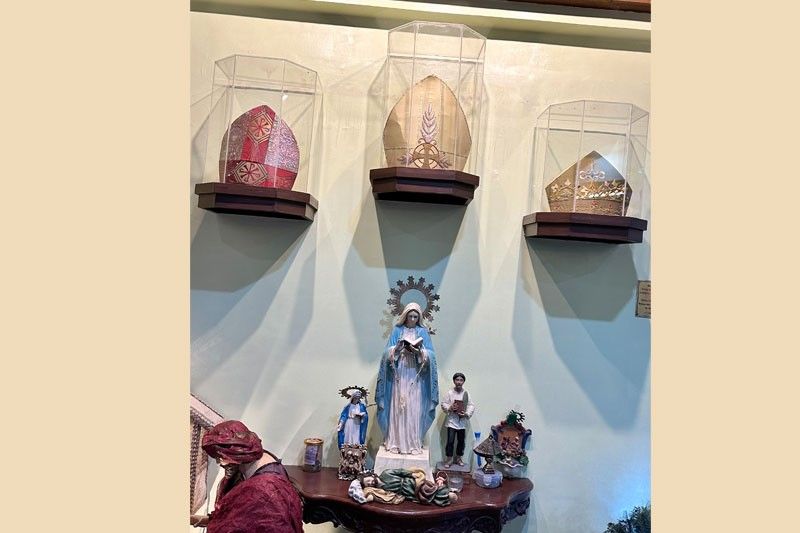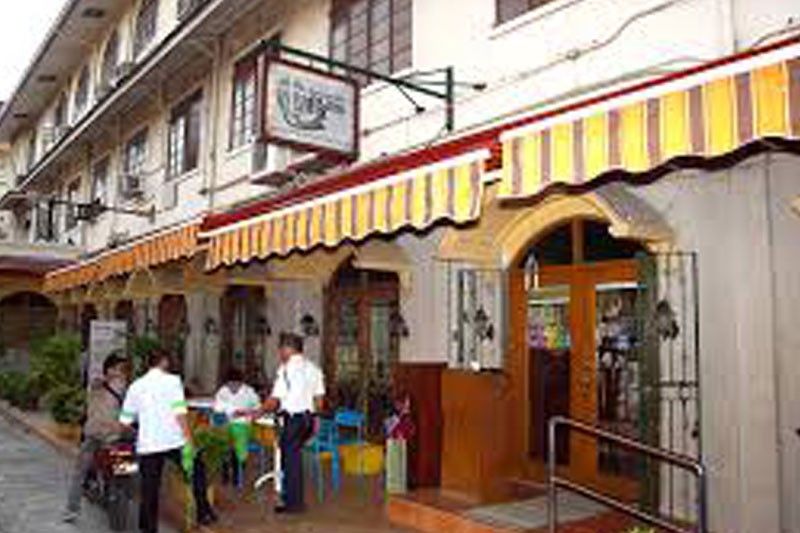Say Grace before you choose your meal

Originally meant for bishops, Ristorante delle Mitre with its ‘churchy’ feel is now open to the flock.
It has been said that food is the central activity of mankind and one of the single most significant trademarks of a culture. This saying could not have held truer as the Christmas holidays beckon to the produce of the stove, where memories of grandma’s recipes resurrect and induce us to salivate, anticipating Noche Buena and the leftovers for lunch the next day.
The stove at this time of the year becomes the inevitable shrine where we convene with our ancestors.
Filipino Christmas food tradition starts with bibingka and puto bumbong
sold in the church plaza after Misa de Gallo, nine days before Christmas Eve. And if you had (as I did) church mice for grandparents, these dawn “kakanins” were treats, but only after attending a sung Mass. Growing up with that tradition, food and spirituality connected quite thickly, especially because bishops, archbishops, parish priests and nuns were frequent visitors in my grandparents’ home.

And so it was that when I first was invited to lunch at this restaurant called Ristorante delle Mitre and I saw their 36-page pamphlet-like menu, the dishes listed were like an instant flashback to childhood. The proximity of the restaurant to an iconic and important Philippine church, San Agustin, contributed even more to the déjà vu since special family occasions were sometimes celebrated there.
Opening in 2010, restaurant owner Elvira Go traces the start of the restaurant as a “concept for a coffee shop inspired by Italian coffee shops,” which resulted from a conversation of wishful thinking among Filipino bishops based in Rome, that they, too, would have a similar venue in the Philippines. A few years later, one of the bishops, Bishop John Du, now archbishop of Palo, Leyte, asked Go to help put up the restaurant for use of the Catholic Bishops’ Conference of the Philippines whose offices now occupy the restaurant’s upper floor. It is the first Catholic-themed restaurant in the country.

The restaurant’s name, Ristorante delle Mitre, “restaurant of the miters,” refers to the celebratory hat a bishop wears for liturgical festivities. Its menu reads like a mouthwatering list of “grandma” dishes that have now been sidetracked by molecular gastronomy. Groupings of dishes are attributed to any one of 68 bishops and archbishops (including one from Yangon), seven priests, four nuns, an Italian Apostolic Nuncio to the Philippines, another one appointed to New York, three Filipino cardinals, three cardinals from the Vatican, one Brother and five spiritually known lay people, representing 38 provinces.
As it was originally meant only for the Bishops’ use, it has now opened its doors (and extensive menu) to the Bishops’ “flock,” where everyone is invited to partake of the Lord’s bounty… a place for dining and relaxation after a day’s toil,” as quoted from the menu’s inner cover page. Today it caters to a wide variety of clientele, including tourists, who are “partly served by some differently abled staff,” explains Go.
Although its interiors recall a 19th-century living or dining room of a traditional “bahay na bato,” when stepping into the restaurant, one cannot help but get a “churchy” feeling, mainly because of its ecclesiastical décor: statues of angels carrying candelabras, as well as a number of ciboriae (an ornate round frame on a stand to expose the Holy Eucharist) perch on wall sconces that may habitually cause one to genuflect before occupying his seat at the table.
Emblems of the Archdioceses of Manila, Cebu and Zamboanga adorn the walls, along with those of the Jesuits, Augustinians and Franciscans. A portrait of the martyred Filipino saint, San Lorenzo Ruiz, hangs prominently on a main wall. Group pictures of bishops taken during their conferences, I presume, spread out on the walls. Memorabilia mugs are displayed in glass cases. Prominent is the centerpiece composed of three miters under glass, supposedly belonging to the three Filipino bishops who are candidates for beatification and eventually canonization for sainthood: Bishops Alfredo Obviar of Lucena; Teofilo Bastida Camomot of Jaro, Iloilo; and Alfredo Verzosa of Lipa, Batangas.
The ultimate room for comfort is not neglected, as the entrance that leads to the ladies’ and gentlemen’s rooms welcome the discomforted with a pair of carved cherubs on its swinging doors.
Ordering takes a bit of time as one wades through each food category and each bishop’s favorites: Filipino and Western breakfasts served with freshly brewed coffee or chocolate eh, Spanish tapas, eggs cooked several ways, 14 choices of soups, seven salads, Filipino main dishes, Comida China, traditional Spanish mains like bacalao, granny meats like pochero and chicken galantine, and 24 seafood dishes.
There are set menus to help your pairing choices, pastas, pizzas, sandwiches, two full pages of desserts and “kakanins,” 53 choices of fresh juices, smoothies and shakes, 30 choices of tea and coffee variations, 14 drinks, sodas and beers, and finally, 46 desserts.
The restaurant is now a tourist destination, the final stop after a tour of historic Intramuros, a heritage zone holdover from the Spanish colonial era, almost flattened to the ground during the Battle of Manila in 1945, and the San Agustin Church, one of the four Baroque churches of the Philippines declared a World Heritage Site, which was one of the rare structures that survived the city’s massacre, a haven to wind down, not a paradise lost.
“Govern well thy appetite,” John Milton advised. Choosing from the bishops’ choices, take your time and good luck.



















